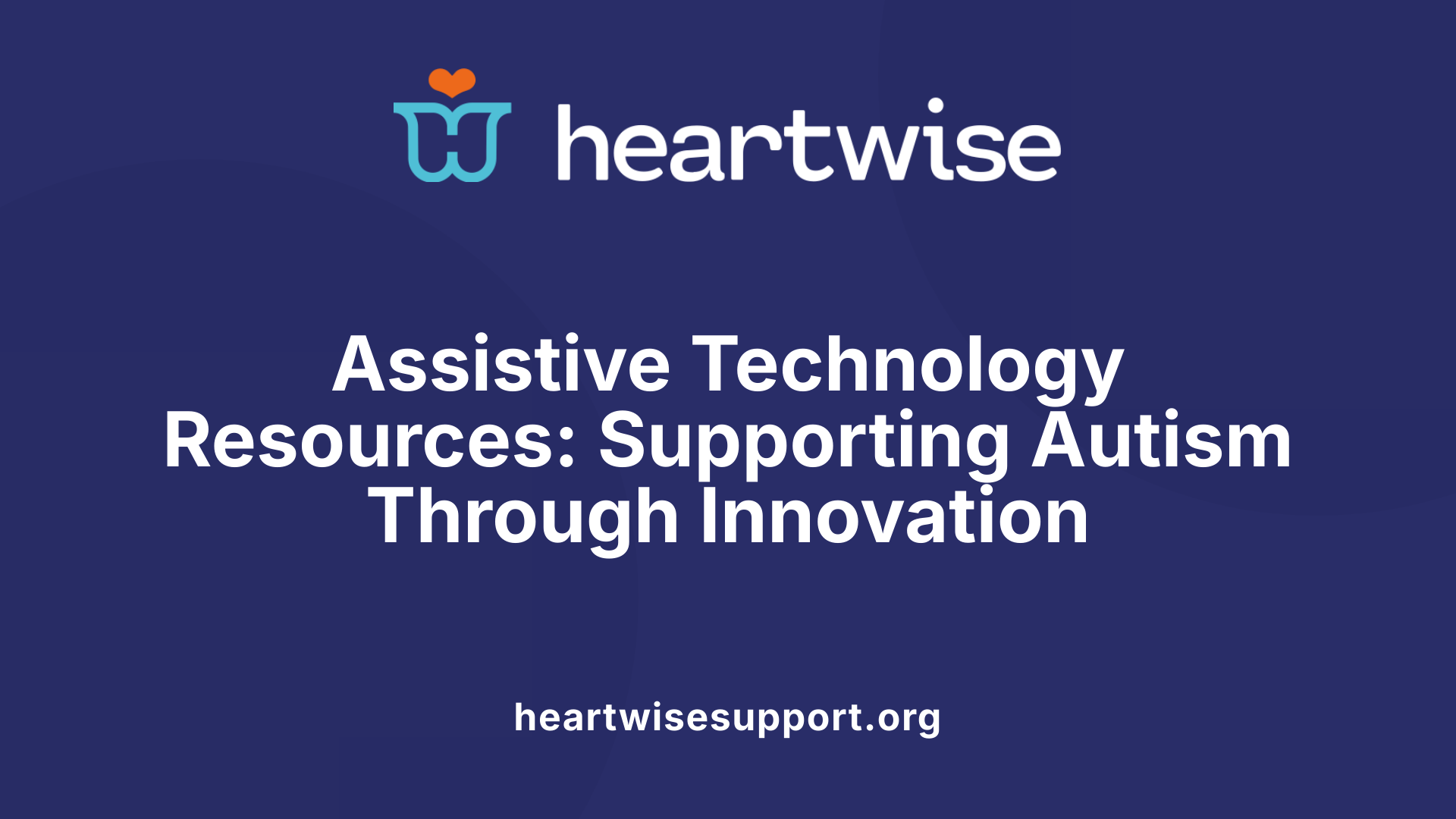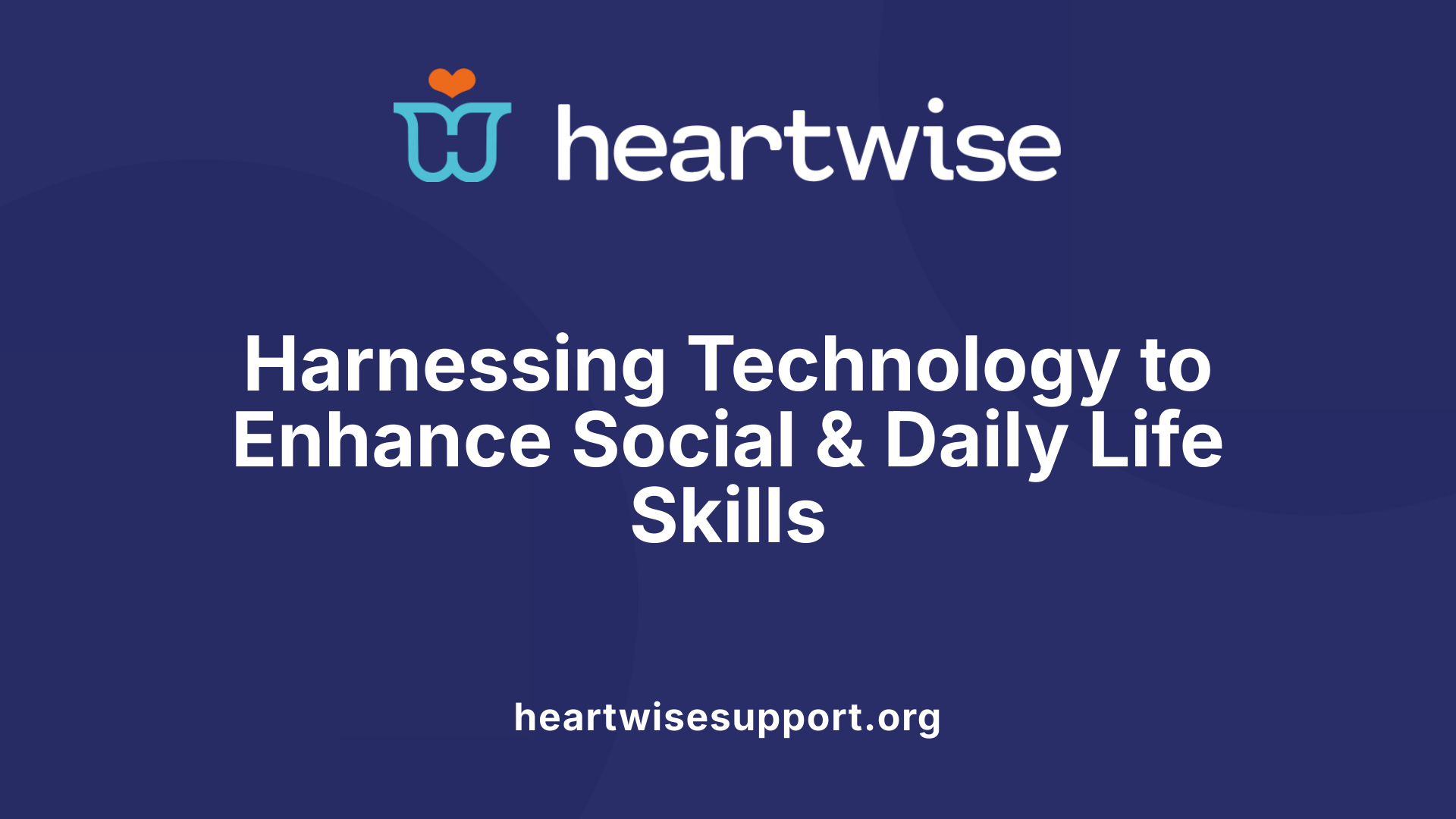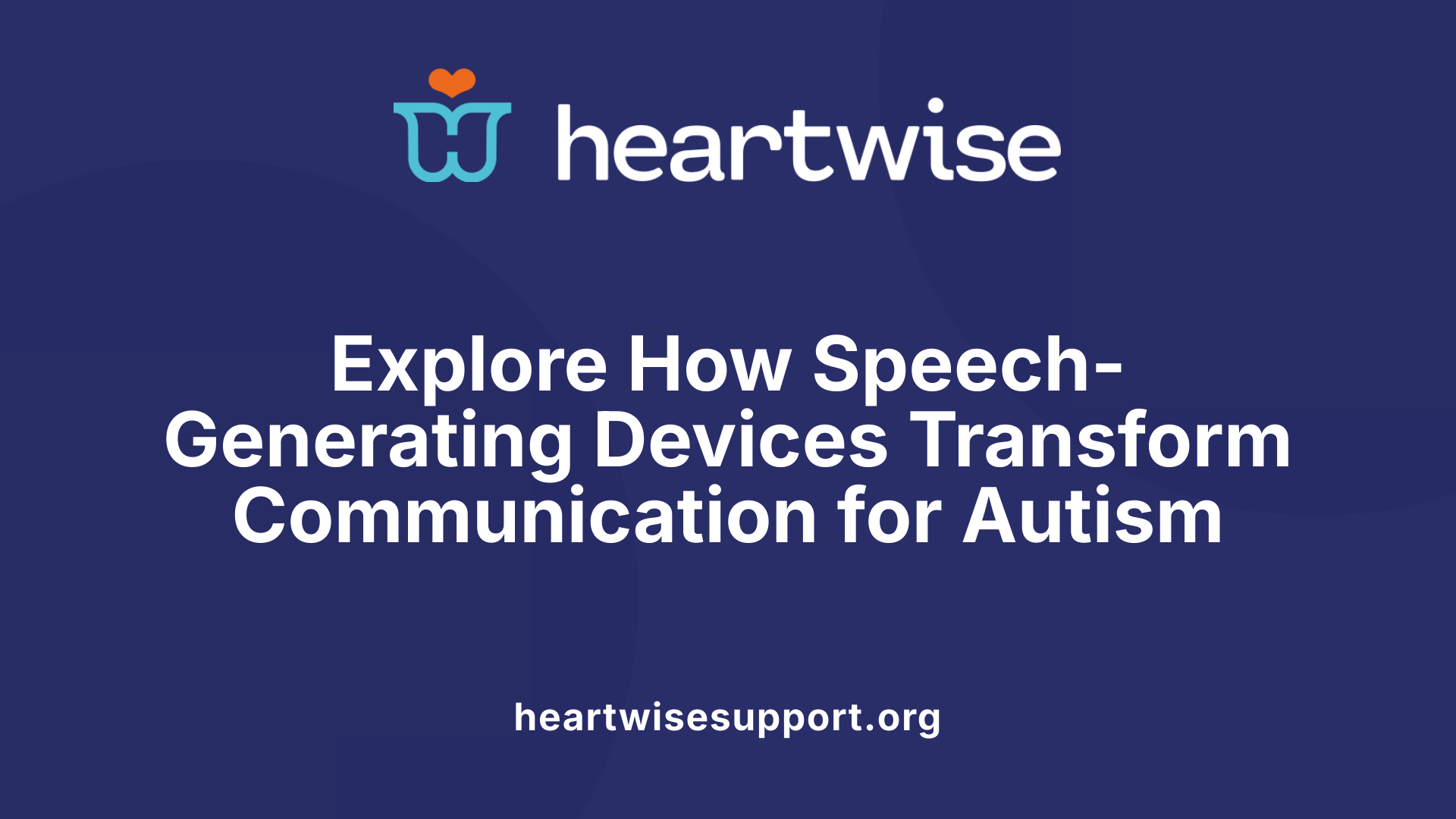Enhancing Communication Through Technology
Advancements in speech therapy tools and assistive technologies are revolutionizing support for individuals with autism. From high-tech speech-generating devices to engaging apps and robotics, these innovations empower learners, promote independence, and enhance social skills. This article explores the wide array of available tools, their functionalities, and strategies for effective integration to improve communication outcomes for autistic individuals.
Understanding Assistive Technology Resources for Autism Support

What are assistive technology tools and resources available for supporting individuals with autism?
Assistive technology encompasses a broad spectrum of tools and resources designed to support and improve the lives of individuals with autism. These technologies include electronic devices, software applications, systems, and strategies tailored to enhance communication, independence, and social interaction.
One of the most prominent categories is augmentative and alternative communication (AAC) devices. These range from high-tech speech-generating devices and sophisticated apps to low-tech picture boards and sign language systems. Devices such as tablets and smartphones serve as platforms for various AAC apps like Proloquo2Go, TouchChat HD, and Dynavox, which help non-verbal or minimally verbal individuals express themselves effectively.
Software tools like text-to-speech programs, speech recognition software, and visual schedule apps support daily functioning and communication. Technology such as eye-gaze systems allows users with limited mobility to communicate by controlling devices with their eye movements.
In addition to hardware and software, there are specialized systems like PECS (Picture Exchange Communication System), which leverages pictures to facilitate communication, and learning programs such as Articulation Station or CoughDrop, designed for speech practice and language development.
Various organizations actively provide guidance, evaluation, and training to maximize the benefits of assistive technology. The Autism Response Team (ART), for instance, offers personalized support and connects families with resources and expertise. Similar organizations include the Assistive Technology Industry Association (ATIA), which promotes access to emerging tools and innovations, including AI-driven apps, robotics, and adaptive devices.
Other technological innovations include video modeling, social stories creation, and visual communication tools that help users navigate new situations and build confidence. These resources are often customizable, allowing individuals to tailor communication strategies to their specific needs.
Funding options for these tools vary and can include private insurance, Medicaid, and educational programs like the National Disability Insurance Scheme (NDIS) in Australia. The involvement of speech-language pathologists and occupational therapists ensures the optimal selection, implementation, and ongoing assessment of technologies.
Overall, assistive technology resources are vital in fostering communication, literacy, and social engagement, enabling individuals with autism to lead more independent and fulfilling lives.
How Speech Therapy Devices and Tools Foster Communication Growth
What types of speech therapy tools are used for autism?
Children with autism benefit from a variety of speech therapy tools designed to enhance communication skills. These include no-tech options like gestures and facial expressions, low-tech tools such as picture exchange communication systems (PECS) and visual communication boards, and high-tech devices like speech-generating devices, touchscreen apps, and software. These tools are tailored to support individual needs, aiming to foster expressive language, receptive understanding, and social engagement.
PECS, for example, involves teaching children to exchange pictures for items or activities they want, gradually developing their language skills from simple requests to commenting and more complex language use. Sign language, such as Signing Exact English (SEE), also plays a role by supporting functional communication, especially in early stages or with children who are minimally verbal.
High-tech solutions, including speech-generating devices (SGDs) like tablets or dedicated electronic devices, offer dynamic ways for children to communicate. These devices often include software and apps specifically designed for autism therapy, enabling users to vocally express words and phrases, customize communication boards, and develop language skills at their own pace.
What features are found in AAC devices like speech-generating devices, apps, and visual communication boards?
AAC (Augmentative and Alternative Communication) tools are fundamental in supporting children with autism to express their thoughts and needs. Speech-generating devices (SGDs) and apps are popular choices because they allow users to select symbols, words, or phrases that are then vocalized by the device.
Features of these devices and apps include:
- Customizability: Users or caregivers can easily add or edit icons, words, and phrases to suit evolving needs.
- Personalized scripts: Ability to create and store routine or social scripts to facilitate common interactions.
- Multi-modal communication: Options for visual, auditory, and tactile feedback to engage different learning styles.
- Ease of use: User-friendly interfaces that cater to children and non-verbal users.
- Integration of social stories and video modeling: Support understanding of social situations and cues.
- Portability: Compact devices or apps that enable communication in various settings.
For visual communication, tools like PECS utilize picture cards and boards, facilitating requests and responses. Sign language systems serve as no-tech aids that support naturalistic communication.
What is the role of speech-language pathologists in selecting and training use of these tools?
Speech-language pathologists (SLPs) play a crucial role in individualizing communication tools for children with autism. They conduct comprehensive assessments to determine the most suitable devices or strategies based on each child's developmental level, communication needs, and motor abilities.
SLPs assist families and educators in selecting appropriate AAC systems—be it no-tech, low-tech, or high-tech options—and provide training on how to effectively implement and support their use in daily routines. They teach caregivers how to model device use, encourage consistent engagement, and incorporate communication strategies into natural interactions.
Ongoing supervision and progress monitoring by SLPs ensure that communication devices evolve with the child's skills, addressing any issues and optimizing outcomes. They also collaborate with teachers and other therapists to integrate technology into classroom and therapy settings, fostering a comprehensive approach to communication development.
How do speech therapy tools and devices support communication and language development in children with autism?
Speech therapy tools and devices, especially augmentative and alternative communication (AAC) systems, empower children with autism to express themselves through multiple avenues. They support vocabulary expansion by providing visual and auditory cues, which help children understand and produce language more effectively.
These tools also promote social skills by enabling interactive communication, like asking for objects or commenting on activities. Many children who are minimally verbal or shy find the use of AAC devices less intimidating than speaking, encouraging more participation.
Research indicates that AAC does not hinder speech development; instead, it can serve as a foundation for vocal language growth. Children often progress from using simple requests to combining words and constructing sentences, especially when these tools are used alongside targeted speech therapy.
Furthermore, integrating AAC with behavioral strategies, such as matrix training and language modeling, enhances the child's ability to develop more complex language skills. Personalized, engaging devices make learning fun, which increases motivation and reinforces learning.
What are some examples of effective AAC devices and software?
Several AAC solutions are widely used and supported by research. For children and adults with autism, devices like the 'Proloquo2Go' and 'TouchChat HD' provide customizable communication interfaces with rich visual symbols. These support both simple requests and complex language development.
Apps such as 'SpeakEasy', designed specifically for children with language delays, and 'Speech Blubs', which uses voice and face recognition to enhance vocabulary, are popular choices. Other supportive tools include CoughDrop, a customizable communication app, and Word Vault, which provides extensive vocabulary and tracking features.
Educational and speech therapy apps like 'Articulation Station' help with pronunciation and phonology, while interactive games such as 'Splingo' improve listening and language skills.
How does technology affect language development in children with autism?
Studies show that technology, when correctly implemented, can stimulate language growth and social interaction. It provides immediate, visual, and auditory feedback, which is essential for children with autism who learn best through multisensory input.
Additionally, devices and apps promote independence by allowing children to communicate their ideas and needs without reliance on others. They also bridge gaps in social communication, giving children confidence to participate in conversations.
Importantly, research confirms that AAC devices can facilitate spoken language development. They help children understand how language works, encourage vocalization, and serve as a stepping stone toward verbal speech.
How should devices and apps be selected and used effectively?
Choosing the right communication tools involves careful assessment by qualified speech-language pathologists. Selection should be based on the child’s abilities, preferences, and specific communication goals.
Regular review and updates of the device or app ensure continued relevance and effectiveness. It’s vital to involve families and educators, providing training and ongoing support.
Integrating technology into daily routines and making therapy sessions engaging and enjoyable helps promote consistent use. Monitoring progress and adjusting strategies accordingly supports optimal development.
What services support access to communication technology?
Funding for AAC evaluation and devices can come from private insurance, Medicaid, or school districts. Many organizations, including the Autism Response Team (ART), offer personalized support, connecting families with resources and guidance.
Devices like Lingraphica’s range of AAC tools are designed to be user-friendly and customizable, with professional support for setup and ongoing use. Support teams also assist in learning how best to utilize the devices, ensuring children get the maximum benefit.
By combining personalized assessments, professional guidance, family involvement, and ongoing support, speech therapy tools and devices significantly contribute to the communication growth of children with autism, fostering greater independence, social interaction, and language development.
Leveraging Technology for Social and Daily Life Skills

How can technology-based interventions, such as apps and robots, improve speech, social skills, and daily functioning in individuals with autism?
Innovative technological tools like apps, robots, and virtual reality environments are transforming autism therapy. These interventions offer engaging, adaptable, and safe platforms for children and adults to develop essential skills.
Robots and interactive platforms are especially effective in teaching social skills and communication. For example, social robots can simulate real-life interactions in a controlled setting, helping individuals practice face-to-face conversations, turn-taking, and emotional recognition. Serious games and learning apps are designed to be fun while targeting specific skills like requesting, vocabulary building, and social understanding.
Wearable sensors and artificial intelligence-driven systems personalize interventions, adjusting difficulty levels and activities based on individual progress. This customization ensures that each person receives targeted support suited to their unique needs.
Another significant benefit is the ability to track progress precisely. Technology can collect data on how often and how effectively a person uses communication devices, participates in activities, or responds to social cues. This data allows therapists and parents to monitor improvements and modify strategies quickly.
Virtual reality (VR) and simulation environments play a crucial role in practicing social interactions in a lifelike yet safe setting. These immersive experiences can help reduce social anxiety and prepare individuals for real-world scenarios, such as shopping, visiting a doctor, or attending school.
Assistive technologies like AAC devices, visual supports, and explicit instructional apps support non-verbal or minimally verbal individuals. These tools encourage communication, foster independence, and help manage daily routines.
Research indicates that these technological interventions improve not only communication skills but also generalize to everyday situations, leading to better social integration and increased independence.
Overall, technology offers versatile, effective approaches to enhance social engagement, communication, and daily functioning for individuals with autism. As these tools continue to evolve, they promise even greater personalized support, fostering autonomy and quality of life.
| Technology Tool | Purpose | Benefits | Examples |
|---|---|---|---|
| Social Robots | Practice social skills | Enhance engagement, simulate real interactions | Buddy, NAO |
| Apps & Serious Games | Build language, social understanding | Fun, interactive learning | Proloquo2Go, Funbrain |
| Virtual Reality | Safe social practice | Reduce anxiety, realistic scenarios | Oculus VR-based programs |
| Wearable Sensors | Personalize interventions | Data collection, real-time adjustments | Sensors monitoring emotional state |
| AAC Devices & Visual Supports | Communication aid | Foster independence, improve interaction | TouchChat, PECS apps |
Utilizing these innovative technologies enables tailored, measurable, and engaging methods for supporting individuals with autism, fostering vital life skills in social, communication, and daily activities.
Understanding How Speech-Generating Devices Work and Their Benefits

How do speech-generating devices work, and what are their benefits for individuals with autism?
Speech-generating devices (SGDs) are sophisticated electronic tools designed to support communication for those who have difficulty speaking. These devices convert text or visual symbols into spoken words, allowing users to express themselves effectively. They can be tablets, specialized equipment, or apps on existing devices that use synthesized or recorded speech to communicate ideas, needs, or feelings.
The core of SGDs includes customizable digital displays where users select symbols, words, or phrases. These selections are then vocally expressed by the device. This flexibility enables adaptation to individual preferences, such as speech style, voice tone, and vocabulary levels. Speech-language pathologists typically evaluate and select the most appropriate SGD for each person, tailoring its features to suit their abilities and communication goals.
Beyond simple vocalization, SGDs have a significant role in fostering independence. They allow individuals with autism to initiate and participate in social interactions more comfortably. Many devices also support literacy development by encouraging users to learn to read and write, further enhancing their communication skills.
Research shows that SGDs do not hinder natural speech development. Instead, they can promote the learning of spoken language, especially when integrated with speech therapy techniques like modeling and language training. These devices help reduce frustration caused by communication barriers and open new avenues for social engagement and self-expression.
In summary, speech-generating devices are valuable tools that convert symbols into speech, tailored to meet the unique needs of autistic individuals. They boost confidence, support social participation, and foster greater independence, making a meaningful difference in the lives of users and their families.
Current Trends and Future Directions in Autism Speech Therapy Technologies
What are current advancements and future directions in speech therapy tools and technologies for autism?
Recent developments in assistive and speech therapy technology are shaping how children and adults with autism develop communication skills. Cutting-edge tools now include artificial intelligence (AI), virtual reality (VR), and wearable devices, which aim to make interventions more precise and engaging.
AI-driven screening tools help identify autism spectrum disorder earlier and more accurately, enabling timely support. Immersive VR environments provide social skills training in controlled, safe settings, allowing users to practice real-world interactions virtually. Wearable devices, like smartwatches and biofeedback systems, assist with emotional regulation and real-time communication support.
Future directions in this field are promising. Researchers aim to include genetic research, advanced neuroimaging, and gene editing to tailor treatments at an individual level. The integration of biotechnology with digital tools could lead to comprehensive, personalized care strategies.
Socially assistive robots are becoming more sophisticated, and some are used to encourage communication, social skills, and sensory integration through interactive play. Mobile apps equipped with artificial intelligence can adapt to users’ progress, providing customized exercises and feedback.
Telehealth platforms are expanding access to therapy, especially in remote areas, enabling families to receive expert guidance without the need to travel. Robotics and remote-controlled devices further support therapy by offering engaging, responsive interactions.
Overall, the trend points towards highly personalized therapy options that leverage interdisciplinary innovation. These advancements aim to improve efficacy, increase accessibility, and foster better communication outcomes for individuals with autism. The field continues exploring how to combine high-tech solutions with traditional therapy to achieve the best possible results.
| Technology Type | Current Use | Future Potential | Description |
|---|---|---|---|
| AI Screening | Early diagnosis | Personalized interventions | Uses data analysis to identify autism signs earlier |
| Virtual Reality | Social skills training | Realistic and adaptable social practice | Immersive environments that simulate social scenarios |
| Wearable Devices | Emotional regulation, biofeedback | Real-time data collection | Devices that provide emotional and physiological feedback |
| Robotics | Therapy sessions | Autonomous, engaging social companions | Robots that support social, communication, and sensory activities |
| Telehealth Platforms | Remote therapy sessions | Increased accessibility and scalability | Virtual clinics connecting therapists and families |
| Mobile Apps | Communication, skills practice | Adaptive, personalized learning | Apps with AI that tailor exercises to individual progress |
As the field evolves, it becomes evident that combining these emerging technologies with traditional speech and behavioral therapies will be essential. Collaboration among researchers, clinicians, developers, and families will drive innovation, making interventions more effective and accessible for everyone.
Guidelines for Choosing Effective Speech Therapy Tools and Resources

How can caregivers and educators select appropriate speech therapy apps, devices, and approaches for autism intervention?
Selecting the right tools to support communication in children with autism is an essential step toward improving their social and language skills. Caregivers and educators should begin by carefully assessing the individual needs, goals, and preferences of the child. This includes understanding their sensory sensitivities, cognitive levels, and specific communication challenges.
Consulting with qualified professionals, such as speech-language pathologists, ensures that choices are based on evidence and tailored to the child's developmental profile. These experts can recommend effective apps and devices that align with the child's abilities and objectives.
When evaluating apps and devices, consider features that promote engagement and usability. Good communication tools often include visual supports, spoken words, and customization options such as uploading personal photos or symbols. This personalization makes the devices more relevant and engaging for the user.
Assistive communication systems, like AAC devices, should be chosen based on whether they are aided (like speech-generating devices or specialized apps) or unaided (such as gestures or sign language). Selection should also involve considerations of portability, simplicity, and the ability to adapt as the child develops.
Implementing these tools effectively involves training communication partners—parents, teachers, and therapists—to model their use consistently. Reinforcing attempts, rewarding progress, and maintaining accessibility encourage children to use tools independently.
Ongoing collaboration with professionals, alongside regular monitoring and adjustments, helps to ensure that these resources remain suitable and effective. Integrating devices and apps into daily routines within a supportive environment maximizes their impact and fosters sustained development.
Overall, choosing the right speech therapy tools is a dynamic process that should be personalized, evidence-based, and supported by professional guidance to optimize communication outcomes for children with autism.
Empowering Through Technological Innovation
The landscape of speech therapy tools and technologies for autism continues to evolve rapidly, driven by innovations in AI, virtual reality, and user-centered design. These tools are making communication more accessible, engaging, and effective, providing individuals with autism the opportunity to express themselves confidently and participate fully in social and daily life. Collaboration among clinicians, caregivers, and technologists is essential to leverage these advancements optimally. By understanding the available resources and selecting appropriate, evidence-based solutions, families and educators can significantly enhance the quality of life and developmental outcomes for autistic individuals. As research progresses, future developments promise even more personalized and integrated approaches, ensuring that every individual receives tailored support that fosters independence, social interaction, and lifelong communication skills.
References
- Technology and Autism
- Autism and speech devices: Helping kids advance skills as they ...
- How AAC devices for autism empower communication - Lingraphica
- Effective ASD Communication Tools at Home | Forbrain - Blog
- Integrating Technology into Speech Therapy: Innovative Tools and ...
- Assistive Communication Devices for Children with Autism
- Using Technology for In-Home Speech Therapy: Apps and Tools for ...
- Augmentative and Alternative Communication (AAC) - ASHA











